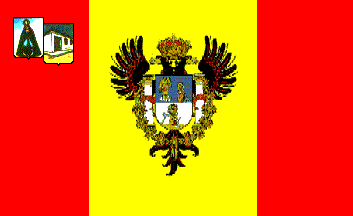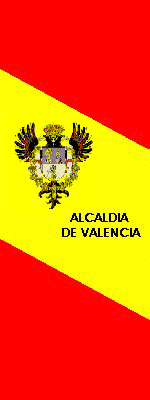 klaus-michael schneider
klaus-michael schneider
Keywords: carabobo | valencia |
Links: FOTW homepage | search | disclaimer and copyright | write us | mirrors

Last modified: 2021-08-26 by  klaus-michael schneider
klaus-michael schneider
Keywords: carabobo | valencia |
Links: FOTW homepage |
search |
disclaimer and copyright |
write us |
mirrors
 image contributed by Eudhen Perdomo and José Manuel
Erbez, 27 March 2009
image contributed by Eudhen Perdomo and José Manuel
Erbez, 27 March 2009
See also:
Valencia is one of the most important industrial cities of my
country: it's located on the Center North of Venezuela and is the
Capital of Carabobo State.
Raul Jesus Orta Pardo, 2 April 2003
In "El
Carabobeño", 3 December 2008, Alfredo Fermín reports
that the newly elected municipal administration plans to change
the municipal flag, arms and anthem.
The leaflet "Símbolos de la Ciudad", including even
more details, can be downloaded (at least for the moment) from
the municipal
website.
Ivan Sache, 6 December 2008
The rules of the competition "Creation of the new flag of
the Municipality of Valencia" are available on the municipal website.
Everybody, aged 15 or more, can compete, except the members of
the Municipal Council, of the municipal administration, of the
jury, and their relatives.
The municipal flag will be used, alongside with the flags of
Venezuela and of Carabobo, in all official events and ceremonies.
Each contender, individual or as a group, shall present a single,
brand new, proposal. A black and white construction sheet shall
be appended to the colour design, as well as a description of the
flag and its meaning.
The competition, opened on 2 February 2009, shall end on 27
February 2009. The jury will then have 20 days to select the
winning design.
On 25 February 2009, "El
Carabobeño", reminding the competition deadline and
basic rules, stated that only 15 proposals had been received yet.
Ivan Sache, 28 February 2009
"El
Carabobeño", 25 March 2009, reports that the Municipal
Council of Valencia has presented the new municipal flag on 24
March 2009"
"Last Tuesday Municipal Council presented the new Flag of
Valencia, where predominate colors are red and terra-cotta’s
brown and where was eliminated the figure of Virgin del
Socorro, Celestial Matron of our city for almost 400 years.
The flag is conformed by eight elements: the colors silver gray,
vermilion red and terra-cotta’s brown; the little feminine
figure called “Valencioide” with white borders, mixed
black lines, the Lake of Valencia and internal black borders
The flag was selected between 25 proposals. His designer was the
Information Engineer Alvaro Manuel Bramante, 23 years old, Unitec’s
graduate and born in Santa Rosa Parish
In the act were present among other persons the Councilmen
Alexis López, Oswaldo Di Lorenzo, Víctor Suárez, Luis Ortega.
There were also César Dao, Alfredo Barrios y Ramón Belisario
which jointly with Maricinia Alvarez and Laura Rojas conformed
the Jury which choose the winning project.
Gray represents the industrialization process which transformed
Valencia in a productive city of the Country. Vermilion red
symbolizes the blood spilled by Tacariguas Indians during the
conquest and colonization process and also the blood spilled by
the patriots in the immortal Field of Carabobo.
The little feminine figure “Valencioides” represents
the so called “Venus Tacarigua”. With her is emphasized
the great original historical, ethnic and cultural value of our
city emanated from its original settlers, who reverenced her as
universal goddess.
The white borders of the little feminine figure symbolizes the
virginity, purity and innocence of Tacariguas Indians, as well as
the value of the cultural knowledge which they bequeathed to
Valencian people. Terra-cotta brown means the original
idiosyncrasy, the cultural value and historical legacy of
Valencia as a city, besides its agricultural fertility.
Mixed lines represent Cabriales River and the great route that it
does through Valencia and also the commitment of the citizens to
recover it. Lake of Valencia alludes to that on their
margins gave rise the establishment of the original
settlers, besides constituting a paradisiac reserve of flora and
fauna. The black borders represent the enigmas, fears or
mysteries which were object Tacariguas Indians during Valencia’s
colonization and also the Patriotic Army during the fight for the
independence of Venezuela.
The winner of the contest will receive 6 thousand strong bolivars
as prize. Four thousands will be contribution from the Mayorship
and 2 thousand from Municipal Council. The flag is not
still official, because it’s required to approve it in the
second reform to the Decree about Civic Symbols”
Ivan Sache and Raul Jesus Orta Pardo, 25 March
2009
 (2:3)
image by Guillermo T. Aveledo, 22 October 2003
(2:3)
image by Guillermo T. Aveledo, 22 October 2003
Flag of Valencia is
available at <www.valencia2002.com>.
Dov Gutterman, 2 April 2003
The Flag - Attributes and Semiology: Consists of a field with
approximated ratio 2:3; this is, square and half of length
vertically divided in three stripes: a yellow one on the center
occupying 2/4 parts of the field and two reds, one to the hoist
and the other to the fly occupying the rest 2/4 parts. Completes
the design the Municipality Coat of Arms on the center an two
escutcheons French shaped at the cantón on the hoist red stripe:
one with the image of Our Lady of Socorro (Succour) and another
one with a colonial facade slightly descended with respect to the
previous one. Even though it seems to be inspired on the Flag of
Spain, the official description determines that the yellow stripe
remembers the radiating light of the sun which appeared when
concluding the Battle of Carabobo on June 24th, 1821,
illuminating the definitive independence of the Venezuelan Mother
country. The red stripes symbolizes the heroic blood spilled by
the Valencians patriots during the sites which underwent Valencia
on March and Juy of 1814. The Coat of Arms reaffirms the
municipal identity. The image of Our Lady of Socorro raises this
Marian invocation as secular Matron of the people, the city and
the Arquidiocese of Valencia alluding to its religious spirit.
The colonial facade represents the so called "Casa de la
Estrella" (the Star's House): historical place where was
signed the first National Constitution of the Republic of
Venezuela and its separation of Great Colombia.
Historical Synthesis: It was created by Professor Pedro Gramcko.
Coat of Arms - Attributes: Consist in an Hispanic shape divided
per fess. The Quarter of the Chief enameled in Azure (blue)
reproduces the scene of the Announcement with the Holiest Virgin
postroad to the sinister and the Archangel Saint Gabriel to her
dexter, both in their colors. The Quarter of the Base enameled in
Argent (white) reproduces the image of Saint John the Baptist
terraced in its colors. As external ornaments the blazon shows a
extended and bicephalous eagle in Sable (black), with delineated
pens in Gules (red) and crowned put behind to the field holding
with its claws two Jonic columns in Or (yellow) and Argent
(white) laced with pennants of Gules (red) that loads as mottoes
the Latin inscriptions "PLUS" (More) to the dexter
"ULTRA" (There) to the sinister, all rounded by the
Great Cord of the Orden Toisón de Oro (Order of Golden Fleece).
Semiology: Its configuration exposes that probable and
unofficially these Arms derives from the Imperial ones of Charles
I of Spain and V of Germany. The First Quarter emphasizes the
invocation of Our Lady who was dedicated to Valencia from its
foundation which is commemorated on March 25th, the Announcement
Day. The Second Quarter reminds the town of Borburata at which
arrived the first settlers of Valencia and whose Patron, Saint
John the Baptist, have been and continuous being venerated by the
Venezuelan coast's inhabitants; in addition, the image of this
Saint has been present since remote times on the Coat of Arms of
the city, according to testify acts of the Municipal Council and
old inhabitants of the place. The eagle under this configuration
remembers the House of Austria (Hapsburg) that reigned on Spain
between 1517 (Charles I of Spain and V of Germany) and 1665
(Charles II of Spain) soon to be happened by House of Borbón,
ruling at the moment. The crown alludes to the kingdom of Spain.
The columns reminds the so called "Pilares de Hercules"
(Hercules Pillars) on the Strait of Gibraltar, place where
concluded the world according to belief of the old Romans. The
original motto was "NON PLUS ULTRA" (Not more there')
until Charles I of Spain commanded to omit the word
"NON" in order to indicate that his kingdom extended
beyond the "Pillars". The Great Cord of the Golden
Fleece, Order established by Spaniard king Felipe "El
Bueno" (Phillipe, called "the Good") seems to
evoke the classic legend of the Golden Fleece: legendary lamb
whose wool was golden and to which were attributed extraordinary
powers that arrived at hands of Jason, captain of the Argos and
its Argonauts: although its presence in this Coat of Arms is
discussed because is granted exclusively by the Spanish monarch,
it can be considered legitimate because embellishing the
Valencian Arms since its first well-known representation. Doesn't
fit doubt about the ancient Hispanic root of Valencia which
reveal the ornaments of this blazon.
Historical Synthesis: Its first well-known illustration dates
since 1804 although doesn't know its origin. It happened through
a period of latency until was rescued by Sr. Oswaldo Feo
Caballero and Dr. Julio Centeno, Jr., being based on acts of the
Municipal Council of Valencia; the historical contributions of
Mr. Sr. Rafael Saturno Guerra, First Official Chronicler of
Valencia and Don Enrique Bernardo Núñez, First Official
Chronicler of Caracas and the artistic contribution of Professor
Pedro Gramcko.
Sources: Bulletin elaborated by Dr Guillermo
Mujica Sevilla, Municipal Chronicler, emitted by the Council of
Valencia Municipality and provided by Prof. Julio César Centeno
Rodriguez, Chronicler of San Diego Municipality, November 2001.
Raul Jesus Orta Pardo, 22 October 2003
Charles II (and the Spanish Hapsburg branch with him) reigned
until 1700. Philip the Good was not a Spanish king - his
descendant Philip the Handsome was (but did not establish the
Order, only introduced it in Spain). It was not exclusively since
the Austrian Hapsburgs continue(d) to do so.
Santiago Dotor, 6 November 2003
g)val.gif) image by Guillermo T. Aveledo, 22 October 2003
image by Guillermo T. Aveledo, 22 October 2003
 image by Guillermo T. Aveledo, 19 April 2002
image by Guillermo T. Aveledo, 19 April 2002
This is an image which I did after visiting Valencia in
Christmas several years ago, with my notes of Valencian banners
that the mayor office had placed, hoisting it in each post of
light of the most central avenues of the city.
Guillermo T. Aveledo, 19 April 2002
g-val.gif) image by Guillermo T. Aveledo, 19 April 2002
image by Guillermo T. Aveledo, 19 April 2002
Based on www.alcaldiadevalencia.gov.ve.
Guillermo T. Aveledo, 19 April 2002